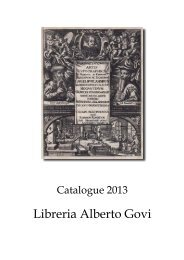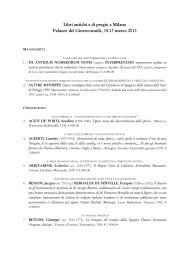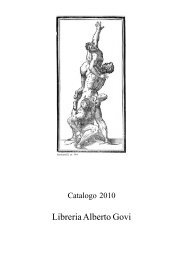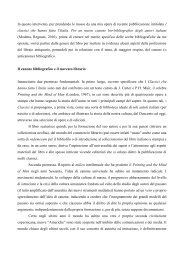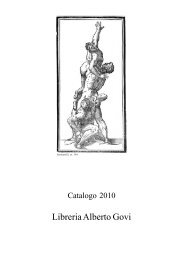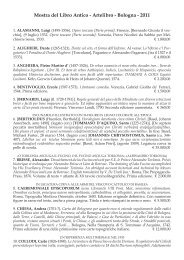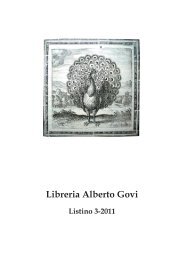List 4-2013 - Libreria Antiquaria Alberto Govi
List 4-2013 - Libreria Antiquaria Alberto Govi
List 4-2013 - Libreria Antiquaria Alberto Govi
Create successful ePaper yourself
Turn your PDF publications into a flip-book with our unique Google optimized e-Paper software.
fined manner. During the course of the thirteen nights, the men are invited every now and then to replace a woman and tell a tale. In addition,<br />
Lucretia herself tells two tales… The stories created by Straparola are literary fairy tales, revised oral tales, anecdotes, erotic tales, buffo tales<br />
of popular Italian life, didactic tales, fables, and tales based on writers who preceded him such as Boccaccio, Franco Sacchetti, Ser Giovanni<br />
Fiorentino, Giovanni Sercambi, and others. In the fairy tales, as well as in most of the other narratives, Straparola focuses on power and fortune.<br />
Without luck (magic, fairies, miracles), the hero cannot succeed in his mission, and without knowing how to use the power of magic or taking<br />
advantage of a fortuitous event or gift, the hero cannot succeed. Though wicked people are punished, it is clear that moral standards are set only<br />
by the people in power… If Straparola did indeed spend most of his life in Venice, it would not be by chance that the tales that he read and<br />
heard came to this port city from far and wide. Venice was a thriving and wealthy city in the sixteenth century, and Straparola would have had<br />
contact with foreigners from all over Italy, Europe, and the Orient. Or he would have had news about them. This real ‘news’ formed the basis<br />
of the fiabe (fairy tales) in his collection, and it is a collection that also traveled far and wide” (J. Zipes, Cross-Cultural Connections, in: “The<br />
Great Fairy Tale Tradition: From Straparola and Basile to the Brothers Grimm”, New York-London, 2001, pp. 852-854).<br />
“La critica ha sempre considerato Le piacevoli notti un unicum nel panorama novellistico rinascimentale, perché in esse si attua diffusamente<br />
la volontà e si esercita concretamente lo sforzo di dare<br />
forma letteraria alla fiaba popolare, trasfigurandola artisticamente<br />
secondo gli schemi e i moduli tradizionali della novella<br />
decameroniana… L’intuizione delle potenzialità narrative del<br />
materiale fiabesco non consentì [tuttavia] allo Straparola di<br />
portare fino in fondo il suo progetto innovativo imponendo<br />
la fiaba come espressione letteraria alternativa, e dunque l’eruzione<br />
di questa materia, fluida e magmatica, viene subito canalizzata<br />
all’interno della tradizione decameroniana attraverso la<br />
presenza di una cornice in cui si innestano le diverse ‘favole’.<br />
Lo scrittore avverte immediatamente l’urgenza di definire le<br />
coordinate spazio-temporali dell’operazione narrativa: rimanda<br />
alla tradizione del realismo borghese l’incipit della cornice<br />
con la presenza di personaggi storici come Ottaviano Maria<br />
Sforza, vescovo di Lodi, costretto a riparare a Venezia, e di<br />
sua figlia Lucrezia Sforza Gonzaga, moglie di Giovan Francesco<br />
Gonzaga…; e inoltre, sembra storicamente plausibile<br />
l’accoglienza benevola riservata ai due illustri esuli dal mercante<br />
trevigiano Ferrier Beltramo…; e soprattutto la scelta di<br />
- 48 -



